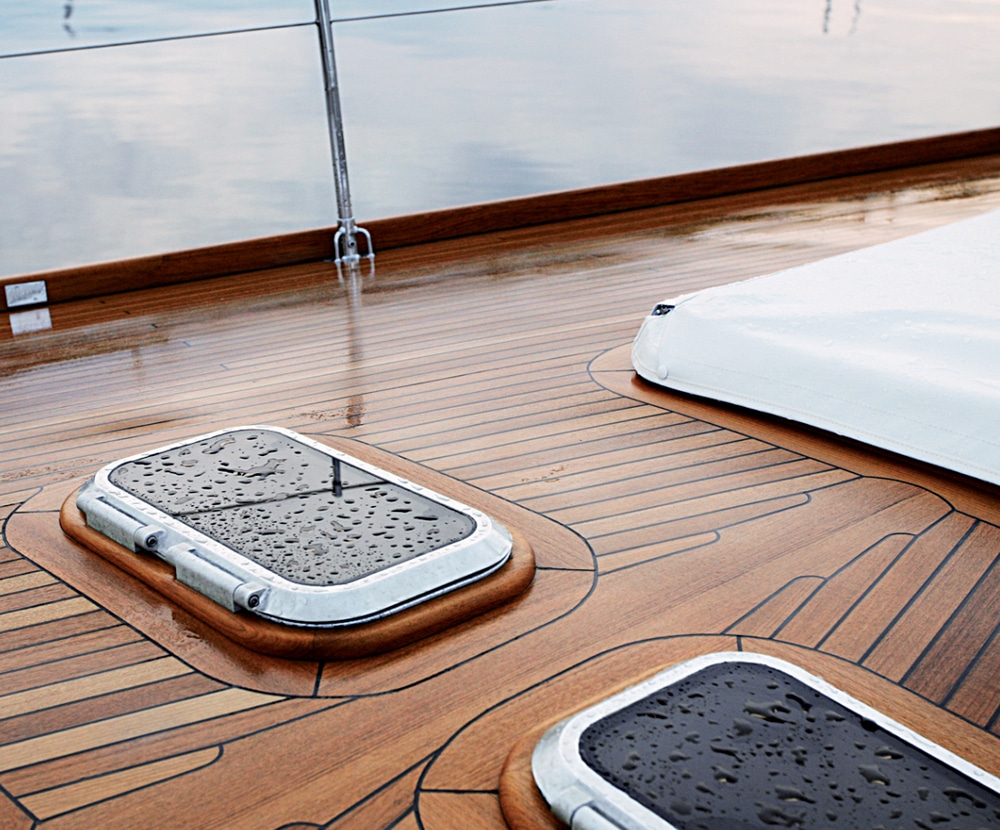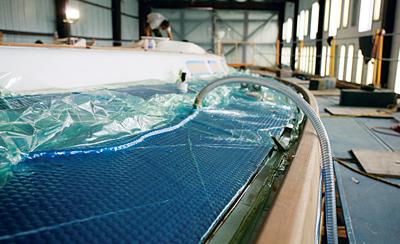
High-Tech Teak
Setting one’s bare foot on the silky, sun-warmed teak deck of a boat is one of those sensations that transmits right up your leg to your brainstem, releasing an elusive combination of cerebral chemicals that says “Welcome aboard,” and carries with it the bliss of spending time at sea. But like most things these days, the message that teak brings — both to those on board and those dockside admiring the fineness of grain and workmanship — has changed. And believe it or not, it’s gotten better.
Teakdecking Systems in Sarasota, Florida, has used a combination of technique and technology to bring teak decks into the 21st century. “Think about it from the point of view of the owners and the shipyards,” says Peter Wormwood, a project manager for the company. “Traditionally, when you were building a boat and it got to be time to put the teak on the deck, you would tie up your best carpenters for weeks and weeks. And, oh, by the way, they’re in the way of everybody else trying to get their jobs done.” For anyone who has enjoyed teak decks, that investment in time and labor was worth it.
Consider Volpaia, a Swan 68 built in 1994, run by Capt. Cyrus Foote and his wife, Brooke, that recently underwent a teak deck refit at Wayfarer Marine in Camden, Maine. Volpaia was Teakdecking Systems’ 10,000th deck in its 28-year history.
“Our old deck was getting quite thin after 15 years of hard sailing and was also attached to the deck using the traditional staple-and-screw method,” Foote says. “The staples were beginning to rust-stain, and the screw holes were beginning to allow leaks to go through the deck after many of the bungs had long since fallen out. Volpaia is a well-maintained vessel, and, despite her age, there were efforts to retap and rebung the screw holes, but in the end there simply wasn’t enough teak material left to drill the screws deeper.” So the boat needed new teak, and boatbuilding technology has advanced in the last 15 years.
“The biggest problem with teak decks all these years was the fastenings,” says Larry Murray of Teakdecking Services in Union, Maine, who installed the decks on Volpaia at Wayfarer Marine. “Because the fastenings equated to holes, holes equated to water getting in and contaminating the subdecks, and basically causing delamination. Once you eliminate the fastening process, now you’ve got an impenetrable deck. And so by removing all of the fastenings and vacuum-bagging these decks down, we’ve taken it to a whole different level.” The only way to keep the traditional look and feel of teak has been to change with the times.
Here’s how the whole process works: The deck-refit schedule is set and a team from Teakdecking Systems is dispatched to meet the boat — wherever she may be in the world — and to create a template of the deck. This is a minimally invasive procedure that can be completed with the boat in the water. The crew manufactures a framework out of 1/8-inch-thick plywood strips around the perimeter of the deck area, assembling a frame that outlines the general shape.
“Onto this framework we just hot-glue little tabs that are pressed up against the toe rail about every six inches to capture that shape, and do the same thing around the hatches and things like that,” Wormwood says. “It looks like a piece of lattice, if you will. The only trick is we have to build it in sections and use line-up lines so we can pack it into a four-by-eight crate and ship down here.”
Meanwhile, the boat continues on her merry way, carrying her owner to quiet anchorages or collecting excited charter guests. “You’ve got two or three months of use or two or three months of planning a refit, if the boat wasn’t being used, that other projects could happen,” says Sandy McGaw, who oversaw the project for Wayfarer Marine in Camden. “Use-wise it’s great. If a guy is planning a winter refit, somewhere in the spring or fall he can stop by, get a template done and go about his season.”
Teakdecking Systems will give a fixed price for materials and installation. When the boat arrives at the yard, the deck hardware is removed, the old deck stripped off and the subdeck prepped and repaired where necessary. The yard takes care of that, and so that part of the project is not included in the fixed price.
“There’s hardware removal and installation and deck prep that not many yards on the planet will estimate on because of the unknowns,” McGaw says. “That’s the biggest consideration in a deck job: ‘What are the other incidentals that go along with it?’ Many costs in the process are unknown when you start the job.” Boat owners who keep good records and documentation — who know how the previous deck was installed, for example — will be able to provide good background to the yard.
At Teakdecking Systems in Sarasota, the new deck is manufactured in pieces, using teak sourced by the company’s world-roving buyers. They hunt for wood from shade-grown trees, which produce hard, finely grained planks that stand up over time. The company developed its own formulations of caulk and epoxy resin, which both cure to the tough result needed to make a durable deck. The teak is affixed to a phenolic backing by vacuum-bagged resin infusion and matched to the template. Then it is boxed up and shipped to the yard.

The deck pieces are vacuum-bagged to the subdeck, eliminating the need for penetrating hardware that would let water in and also eliminating voids where moisture can accumulate. Of course, the vacuum-bagging process is complex, since most decks are not a single, uninterrupted sheet. “When you have a deck with all kinds of deck prisms and hatches, all these different factors, you’ve got to create a very complicated vacuum bag, so it can actually be a time-consuming process, but the end result is worth it,” Murray says. “Basically you have to create separate perimeters around each penetration.”
Because there are no fastenings, there’s no need for bungs, but false bungs can be added to keep the look consistent. Those bungs don’t need to seal off a penetration, so there’s no fear of leaks. And Teakdecking Systems offers a worldwide warranty network, set up during the company’s 28 years in business.
The result is a high-tech way to keep the traditional look and feel of teak.
“It’s what makes a yacht a yacht,” says Murray.
Teakdecking Systems, 941-756-0600; teakdecking.com








